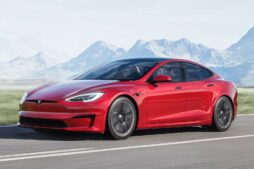Research reveals SUVs unfit for average parking spaces.
It’s no surprise that cars are expanding in size, and while this fact may not have needed scientific confirmation, recent research sheds light on the concerning trend. In Europe, SUVs are at the forefront as the main culprits of this growth, as pickup trucks are less common compared to the United States. This new study emphasizes the urgency for governing bodies to tackle the problem of ever-growing vehicles.
The European Federation for Transport and Environment, a comprehensive organization of non-governmental entities in Europe as described on Wikipedia, has conducted a detailed analysis. The findings show that the width of new passenger vehicles is growing by one centimeter (0.4 inches) approximately every two years. As a result, these progressively larger cars are now too large for roads and parking spaces in Europe.
According to recent research, the average width of a new car has surpassed 180 centimeters (70.8 inches), which is equivalent to a standard parking space on Europe’s roads. This presents a problem in cities with narrow streets, especially those steeped in history. The study showcases a few exceptionally wide vehicles, all of which fall into the category of SUVs. Notably, the BMW X5, X6, X7, and XM all measure over 200 centimeters (78.7 inches) in width. Close behind are the Mercedes GLS, Audi Q8, Porsche Cayenne, and Volkswagen Touareg, just shy of the 200-centimeter mark.
Over the years, traditional cars have also increased in size. The Skoda Octavia, a top choice in Europe, is classified as a compact car despite its dimensions of 4.68 meters (184.6 inches) in length and 1.82 meters (72 inches) in width. Similarly, the ever-popular Volkswagen Golf, which holds the title for best-selling vehicle in Europe, now measures 4.28 meters (168.7 inches) long, a significant increase from the original model’s length of 3.7 meters (145.9 inches).
The steady increase is not solely a result of the need for larger vehicles, but is also influenced by the rising standards for safety. This can be seen in the wider pillars of modern cars compared to those from past decades. As governing bodies require more safety measures, car manufacturers must make room for the necessary equipment. However, with size comes added weight, resulting in negative impacts on the vehicle’s efficiency through higher fuel usage and emissions. Nevertheless, this is a separate issue.
The popularity of SUVs has been a major factor contributing to this alarming trend. Consumers cannot seem to satisfy their demand for these vehicles, and car manufacturers are more than willing to meet it. Furthermore, there is a growing concern for safety, following a recent study conducted by the Belgian Institute for Road Safety. The findings showed disturbing evidence, as data from crashes reported in Belgium between 2017 and 2021 revealed that elevating the front of a vehicle by 10 percent can elevate the chances of a pedestrian or cyclist being fatally injured by 30 percent.
According to the European Federation for Transport and Environment, the only way to put an end to the phenomenon known as “autobesity” is through regulatory measures taken by European legislators.
Source: Transport & Environment






